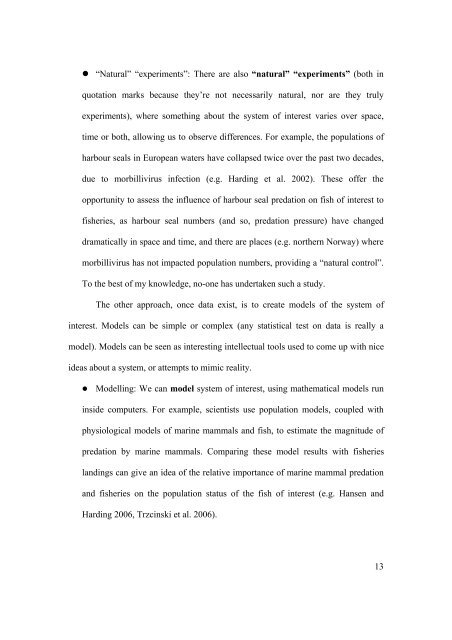ICELAND, - Whale and Dolphin Conservation Society
ICELAND, - Whale and Dolphin Conservation Society
ICELAND, - Whale and Dolphin Conservation Society
Create successful ePaper yourself
Turn your PDF publications into a flip-book with our unique Google optimized e-Paper software.
! “Natural” “experiments”: There are also “natural” “experiments” (both in<br />
quotation marks because they’re not necessarily natural, nor are they truly<br />
experiments), where something about the system of interest varies over space,<br />
time or both, allowing us to observe differences. For example, the populations of<br />
harbour seals in European waters have collapsed twice over the past two decades,<br />
due to morbillivirus infection (e.g. Harding et al. 2002). These offer the<br />
opportunity to assess the influence of harbour seal predation on fish of interest to<br />
fisheries, as harbour seal numbers (<strong>and</strong> so, predation pressure) have changed<br />
dramatically in space <strong>and</strong> time, <strong>and</strong> there are places (e.g. northern Norway) where<br />
morbillivirus has not impacted population numbers, providing a “natural control”.<br />
To the best of my knowledge, no-one has undertaken such a study.<br />
The other approach, once data exist, is to create models of the system of<br />
interest. Models can be simple or complex (any statistical test on data is really a<br />
model). Models can be seen as interesting intellectual tools used to come up with nice<br />
ideas about a system, or attempts to mimic reality.<br />
! Modelling: We can model system of interest, using mathematical models run<br />
inside computers. For example, scientists use population models, coupled with<br />
physiological models of marine mammals <strong>and</strong> fish, to estimate the magnitude of<br />
predation by marine mammals. Comparing these model results with fisheries<br />
l<strong>and</strong>ings can give an idea of the relative importance of marine mammal predation<br />
<strong>and</strong> fisheries on the population status of the fish of interest (e.g. Hansen <strong>and</strong><br />
Harding 2006, Trzcinski et al. 2006).<br />
13
















